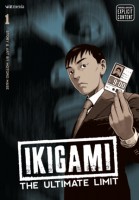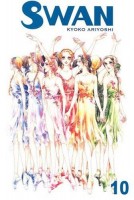My News and Reviews
Two reviews posted last week! First up was Jeffery Angles’ Writing the Love of Boys: Origins of Bishōnen Culture in Modernist Japanese Literature. It’s a very interesting work examining the portrayal of male-male desire in Japanese literature in the early twentieth century. I discovered Writing the Love of Boys while looking for more information about Edogawa Rampo and his writing. The work even briefly addresses boys’ love manga, which I didn’t realize that it would when I first picked up the volume. The second review from last week was of Yoshikazu Yasuhiko’s Mobile Suit Gundam: The Origin, Volume 4: Jaburo. I’ll be honest, since I wasn’t already a Gundam fan, I didn’t anticipate that I would be enjoying this series as much as I am. I’ve actually been quite impressed with the manga. Yasuhiko’s artwork is fantastic and the balance between the individual characters’ struggles and the war as a whole has been excellent. And It doesn’t hurt that Vertical’s edition of The Origin is simply gorgeous.
As for interesting things online: Matt Thorn received An unambiguous response from Asano Inio regarding the use of pronouns and has some final thoughts on the whole affair. I had somehow forgotten about Ryan Holmberg’s What Was Alternative Manga? column at The Comics Journal. The latest article examines Shinohara Ushio’s Action Cartooning. In the most recent House of 1000 Manga column, Jason Thompson uses the return of two boxes of manga amounting to 64 Pounds of Porn as a jumping off point to discuss some of the history of the publication of hentai and ecchi manga in English. Manga translator Amanda Haley was interviewed over at Organization Anti-Social Geniuses. In somewhat older news, but Brigid Alverson and Publishers Weekly now have bit more information about it—Digital Manga, Inc. to Publish Tezuka Backlist.
Quick Takes
 Gangsta, Volume 1 by Kohske. Other than having seen some of the artwork and having a rough sense of the series’ premise, I actually didn’t know much about Gangsta going into the first volume. It turns out that the manga is Kohske’s first series and it seems to be doing fairly well for her. At the very least, I can say that I’m definitely interested in reading more of Gangsta. Worick and Nicolas are two “handymen” who are brought in to deal, often quite violently, with people and situations that for one reason or another the authorities would rather avoid. The two men have dark pasts, ties to organized crime, and a very close relationship with each other, but only one volume in the details have mostly just been hinted at. I like Nic and Worick a lot, and am particularly interested in learning more about Nic and his background. At one point a mercenary, he’s an incredibly skilled and powerful fighter. He’s also a “tag” with superhuman abilities, considered to be a monster or freak by many. Worick can hold his own, too, though. They’re both badasses with attitudes. The supporting cast is also pretty great.
Gangsta, Volume 1 by Kohske. Other than having seen some of the artwork and having a rough sense of the series’ premise, I actually didn’t know much about Gangsta going into the first volume. It turns out that the manga is Kohske’s first series and it seems to be doing fairly well for her. At the very least, I can say that I’m definitely interested in reading more of Gangsta. Worick and Nicolas are two “handymen” who are brought in to deal, often quite violently, with people and situations that for one reason or another the authorities would rather avoid. The two men have dark pasts, ties to organized crime, and a very close relationship with each other, but only one volume in the details have mostly just been hinted at. I like Nic and Worick a lot, and am particularly interested in learning more about Nic and his background. At one point a mercenary, he’s an incredibly skilled and powerful fighter. He’s also a “tag” with superhuman abilities, considered to be a monster or freak by many. Worick can hold his own, too, though. They’re both badasses with attitudes. The supporting cast is also pretty great.
 Ikigami: The Ultimate Limit, Volumes 1-2 by Motoro Mase. In order to encourage the population to value life and increase social productivity, the National Welfare Act is passed. During inoculation, 1 out of 1,000 people are randomly injected with a nano-capsule that will kill them sometime between the age of 18 and 24. The day before they are scheduled to die, they receive death papers—Ikigami—so that they can prepare for their last hours. Ikigami follows those people and how they deal and cope with their impending deaths. It’s a grim subject matter, but handled well. The manga manages to show that even seemingly senseless deaths matter and can have a purpose—people can continue to influence others even after they are gone. At this point, Ikigami seems to be largely episodic. However, there is also an overarching framing story that ties everything together. Kengo Fujimoto is one of the government workers responsible for delivering Ikigami to those who are about to die. He struggles to come to terms with his work and the role he plays within the system as he (and therefore the readers) learn more about it.
Ikigami: The Ultimate Limit, Volumes 1-2 by Motoro Mase. In order to encourage the population to value life and increase social productivity, the National Welfare Act is passed. During inoculation, 1 out of 1,000 people are randomly injected with a nano-capsule that will kill them sometime between the age of 18 and 24. The day before they are scheduled to die, they receive death papers—Ikigami—so that they can prepare for their last hours. Ikigami follows those people and how they deal and cope with their impending deaths. It’s a grim subject matter, but handled well. The manga manages to show that even seemingly senseless deaths matter and can have a purpose—people can continue to influence others even after they are gone. At this point, Ikigami seems to be largely episodic. However, there is also an overarching framing story that ties everything together. Kengo Fujimoto is one of the government workers responsible for delivering Ikigami to those who are about to die. He struggles to come to terms with his work and the role he plays within the system as he (and therefore the readers) learn more about it.
 The Manzai Comics, Volume 1 written by Atsuko Asano and illustrated by Hizuru Imai. I discovered The Manzai Comics due to the fact that it is written by the author of No. 6. It’s a five-volume series, but only the first volume was ever released in English. I was actually quite surprised by The Manzai Comics; it’s a rather delightful and amusing manga. And touching, too, as transfer student Ayumu struggles to overcome his hikikomori tendencies and is almost forcefully befriended by his new classmates. One of the major running jokes is that almost everything that Takashi says to Ayumu when taken out of context makes it sound like he’s hitting on him. When he’s talking about “doing it” and so on, he’s talking about becoming a manzai duo, not boyfriends. (Although it may very well be that Takashi is gay; it’s left as an ambiguous possibility.) In some ways, The Manzai Comics is like a boys’ love manga without actually being a boys’ love manga. People who are at least passing familiar with manzai stand-up comedy will probably get a little more out of it than those who aren’t, but that knowledge isn’t at all necessary to enjoy the story as a whole.
The Manzai Comics, Volume 1 written by Atsuko Asano and illustrated by Hizuru Imai. I discovered The Manzai Comics due to the fact that it is written by the author of No. 6. It’s a five-volume series, but only the first volume was ever released in English. I was actually quite surprised by The Manzai Comics; it’s a rather delightful and amusing manga. And touching, too, as transfer student Ayumu struggles to overcome his hikikomori tendencies and is almost forcefully befriended by his new classmates. One of the major running jokes is that almost everything that Takashi says to Ayumu when taken out of context makes it sound like he’s hitting on him. When he’s talking about “doing it” and so on, he’s talking about becoming a manzai duo, not boyfriends. (Although it may very well be that Takashi is gay; it’s left as an ambiguous possibility.) In some ways, The Manzai Comics is like a boys’ love manga without actually being a boys’ love manga. People who are at least passing familiar with manzai stand-up comedy will probably get a little more out of it than those who aren’t, but that knowledge isn’t at all necessary to enjoy the story as a whole.
 Swan, Volumes 10-12 by Kyoko Ariyoshi. I am still absolutely loving Swan. The Second Annual Tokyo World Ballet Competition is drawing to a close, but the passion and intensity of the dancers is as strong as ever. They are all pushing themselves to the breaking point in order to give their very best performances. Ultimately the competition is too much for some of the dancers, both physically and emotionally, as they are confronted with their own limitations. These particular volumes of Swan emphasize the importance of a dancer’s personal strength and abilities, but also the importance of a dancer’s partner and their ability to work with, rely upon, and support each other. This extends beyond the realm of dance and spills over into the rest of their lives, as well. Years have passed since the story first began; it’s marvelous to see how much Masumi has changed and developed as the Swan has progressed, not just as a dancer but as a person. I like her even more now than I did the beginning. She’s gone through a lot of trials, pain, and suffering for her art, but she has also experienced great joy and satisfaction because of it.
Swan, Volumes 10-12 by Kyoko Ariyoshi. I am still absolutely loving Swan. The Second Annual Tokyo World Ballet Competition is drawing to a close, but the passion and intensity of the dancers is as strong as ever. They are all pushing themselves to the breaking point in order to give their very best performances. Ultimately the competition is too much for some of the dancers, both physically and emotionally, as they are confronted with their own limitations. These particular volumes of Swan emphasize the importance of a dancer’s personal strength and abilities, but also the importance of a dancer’s partner and their ability to work with, rely upon, and support each other. This extends beyond the realm of dance and spills over into the rest of their lives, as well. Years have passed since the story first began; it’s marvelous to see how much Masumi has changed and developed as the Swan has progressed, not just as a dancer but as a person. I like her even more now than I did the beginning. She’s gone through a lot of trials, pain, and suffering for her art, but she has also experienced great joy and satisfaction because of it.
 Gatchaman Crowds directed by Kenji Nakamura. I am only vaguely familiar with the Gatchaman franchise and so wasn’t initially intending to watch Gatchaman Crowds, but after hearing nothing but good things about the series I decided to give it a try. I’m glad that I did because I ended up quite enjoying Gatchaman Crowds. Hajime Ichinose is the most recent member of the Gatchaman team, a group of humans and aliens granted superpowers in order to protect the planet from aliens that would do it and the population harm. She’s an extraordinarily vibrant and optimistic young woman, and at first I thought she was going to be terribly annoying, but Hajime turns out to be a fantastic character and is not nearly as naive as one might expect. Her presence on the team has a huge effect on the other members and they all begin to rethink what it means to be Gatchaman and what their roles as superheros should be. Basically, it’s a series about using your skills and talents to the best of your ability no matter who you are and how even dangerous powers (and technology) can be harnessed for good.
Gatchaman Crowds directed by Kenji Nakamura. I am only vaguely familiar with the Gatchaman franchise and so wasn’t initially intending to watch Gatchaman Crowds, but after hearing nothing but good things about the series I decided to give it a try. I’m glad that I did because I ended up quite enjoying Gatchaman Crowds. Hajime Ichinose is the most recent member of the Gatchaman team, a group of humans and aliens granted superpowers in order to protect the planet from aliens that would do it and the population harm. She’s an extraordinarily vibrant and optimistic young woman, and at first I thought she was going to be terribly annoying, but Hajime turns out to be a fantastic character and is not nearly as naive as one might expect. Her presence on the team has a huge effect on the other members and they all begin to rethink what it means to be Gatchaman and what their roles as superheros should be. Basically, it’s a series about using your skills and talents to the best of your ability no matter who you are and how even dangerous powers (and technology) can be harnessed for good.
